FAQ
- Bolivia climbing questions
-
Mallorca island and rockclimbing
- What are main specifics of rockclimbing trip to Mallorca
- Mallorca island impressions
- Rockclimbing safety Spain
- Mallorca climbing accommodation
- What season is possible for rockclimbing in Mallorca
- Transport accessibility of climbing sectors in Mallorca
- Active vacation in Mallorca
- Saint Anthony night in Mallorca
- Peru climbing questions
- Gear reviews
-
Safety in the mountains
- How NOT to climb the summit?
- Mountain navigation
- At the limit of possibilities
- Mountain thunderstorm
- Solo ascents and mountain trips alone
- Mutual responsibility in mountaineering
- Safety illusions in the mountains - a rope
- Independent team of two
- Mountain troubles
- Psychological problems in the mountains
- Health in the mountains
-
Elbrus questions
- Elbrus climbing gear
- Climbing Elbrus with children?
- Mount Elbrus location?
- Elbrus logistics
- How to get to Mount Elbrus?
- Elbrus German airfield?
- Elbrus difficulty grade
- 5 points beginner must know about Elbrus
- How to prepare for Elbrus?
- Are there avalanches on Mount Elbrus?
- Climbing Elbrus solo?
- Seasonality of climbing Mount Elbrus
- How much time climbing Elbrus takes?
- Clothes for Mount Elbrus?
- Pressure at the top of Elbrus?
- Elbrus air temperature
- Elbrus sightseeing
- How much to climb Elbrus
- Gear questions
- Mountaineering questions
- Mountain climbing training
-
Rockclimbing questions
- Rockclimbing gear
- How to choose your first rockclimbing shoes
- The hand power in roclcimbing
- What is Rockclimbing tours
- Non olymnic rockclimbing
- What is rockclimbing?
- Where do you climb?
- Where and when we organize our rockclimbing programs?
- What is rockclimbing?
- Rockcliming program class?
- Climbing motivation
- Horse riding tours
- Iceclimbing questions
-
Questions on the alpine programs
- What to climb in Morocco?
- Weekend summit climb
- Georgia 2023
- Pico Aneto - what is that mountain?
- Mountain programs format
- Mountain climbing food ration
- Queries on the alpine program climbing Mount Bazarduzu
- Queries on the Kamchatka alpine program climbing
- What is combined program?
- What is sightseeing program?
- What is pilot program?
- What programs you have of the medium complexity level?
- Basic expedition rations
- Prices for the mountain climbing programs
- Queries on the Mountain Course in Adyl Su valley
- Program complexity?
- Questions about MCS AlexClimb
- Questions related to trekking programs
Trekking poles
Read in Telegram in English
Leer en Telegram en Español
MCS AlexClimb Mountain Climbing School
Technological progress in mountaineering has made accessible to us those peaks and routes that were previously conquered only by the titans of mountain climbing. In the mountains we use many technical solutions for our safety, weather protection, navigation and communication.
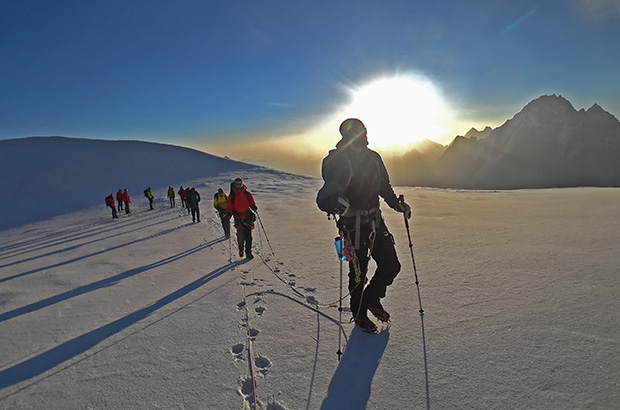
Climbing Mount Gestola in Caucasus, to the right of the rising sun - the massif of Mount Dykh Tau
Almost every aspect of mountaineering has undergone significant technical and tactical changes due to the continuous technological progress in this industry. But there is one invention that, despite its outward unremarkability, is still of key importance in all types of mountaineering, trekking and hiking.
This invention is called trekking poles.
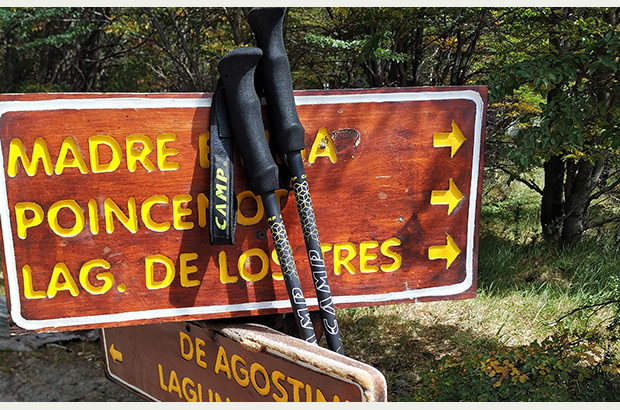
A constant companion on any route in the mountains - folding trekking poles
Many will be surprised and question me this - what is so special with the ordinary trekking poles?! These are just poles, one can walk without them... However, this thesis is fundamentally incorrect, and I will try to explain and convince you that among the numerous technical devices for mountaineering, trekking poles are of highest importance.
Both to facilitate your moving over difficult mountain terrain and even to ensure your physical safety.

Trekking poles are used on any route in the mountains - from the simplest to the most difficult
Let's take a closer look at the subject of this article. What are trekking poles?
As a rule, trekking poles of today are a completely modern technological product, compact, durable and as lightweight as possible.
The folding design (in most cases telescopic) makes it easy to transport trekking poles and adjust their length. There are a lot of design and construction options - trekking poles of different models are produced by almost all manufacturers of climbing equipment.
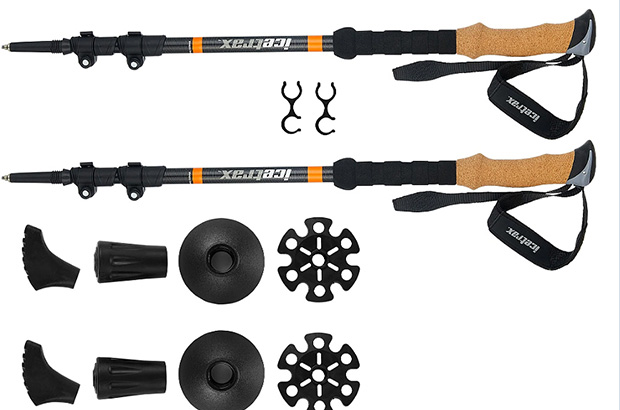
Standard set of trekking poles
Common features of trekking poles include the following:
The maximum length of the poles in working position is 130-150 cm, when folded they are no more than 50 - 70 cm. Anatomical handle made of special material allows you to comfortably use the poles during the long treks. Material if the trekking poles in the most cases is aluminum alloys (inexpensive models, strong and durable), less often - pole are made of carbon fiber plastic which is very light, but expensive and fragile.
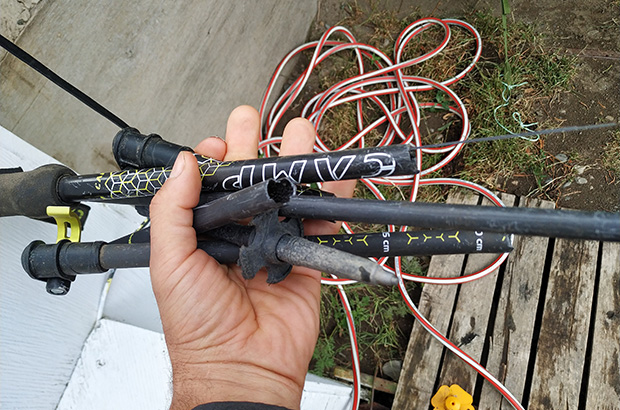
Broken parts of very expensive carbon trekking poles C.A.M.P. - being fragile as glass, they could not stand several days of the approach route to Cerro Torre in Patagonia
Various designs of locking sections (both external and internal) allow you to quickly move trekking poles from folded to working position and adjust them to any required length.
The working end of the poles (opposite to the handle) is usually made of plastic, with a reinforced tip made of steel or a special durable alloy.
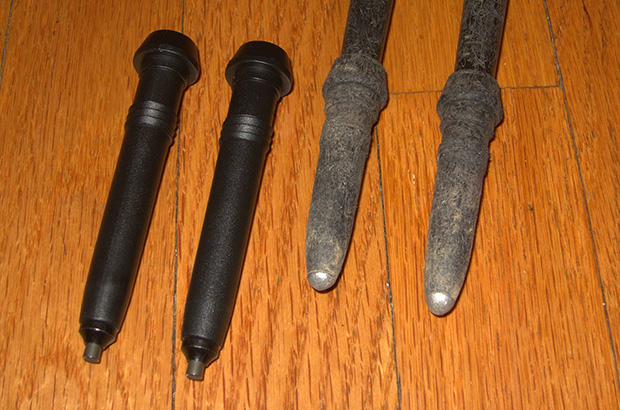
The tip of trekking poles - as it wears out, it is possible to replace it and extend the service life of trekking poles
Why are trekking poles so important in mountaineering and mountain hiking?
First, when moving along the difficult, uneven mountainous terrain, the use of trekking poles can significantly improve your coordination.
Using the trekking poles you get two more points of balance to help you to move safely and quickly. The body control is increasing and the risk of fall is reducing - which in general rises the whole safety of your mountain trip.
Second, due to the improved distribution of the load, by partially transferring the weight of the upper body onto the trekking poles (especially important when carrying a heavy backpack), it is possible to significantly relieve the load on your breast. This makes breathing noticeably easier which is a critical point in the mountain conditions of the lack of oxygen.

Using trekking poles when walking on a glacier
Distributing the load across four points not only makes walking easier, but also increases your safety - for example, when moving with trekking poles on a closed glacier, the likelihood of falling into crevasse is reduced because of distributing the load over a larger area of the snow surface.
Climbing Mount Elbrus - crossing a closed glacier using trekking poles
Another positive aspect of using trekking poles - by analogy with cross-country skiing - when walking, by pushing the trekking pole you give yourself an additional impulse, accelerating and facilitating forward movement. It would be good to learn this technique before going to the mountains. For example, in Nordic walking courses.
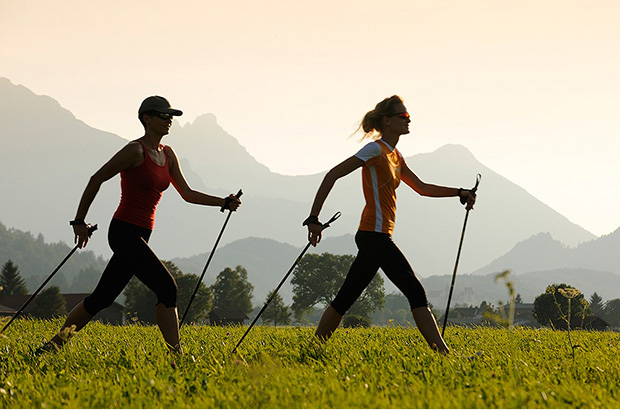
Nordic walking is a specific, but quite useful type of fitness. Among other things it provides confidence in using trekking poles
Even on the terrain where the steepness of the slope not walkable anymore but requires some scrambling, trekking poles can greatly facilitate the task. They can be used as short picks when fixing yourself to the relief. This is safer and more effective than holding on to the relief with your hands, with the risk of rolling out rocks and provoke rockfall.
As a person with 25 years of experience in mountain climbing and organizing expeditions, I can say that without trekking poles I would not go even to the simplest and shortest mountain hike.
Trekking poles and climbing crampons are the only necessary equipment for climbing Mount Elbrus along the south route
Many beginners, having picked up trekking poles, do not realize that they need to be able to use this piece of equipment, just like, for example, an ice ax or crampons.
The technique of using trekking poles consists in the ability to effectively distribute body weight to the additional points of support, thereby improving balance. As well as using the energy of pushing with a pole to accelerate movement - by analogy with classical skiing technique.
Remember - if you have your trekking poles under your arm, you shouldn't expect any benefit from them.
Proper use of trekking poles reduces the load when carrying a heavy backpack
Until you learn how to use this equipment correctly, trekking poles will just get tangled under your feet, giving an advantage in movement only to those who are not too lazy to get used to them, to learn how to use them and understand the necessity of this very important element of the mountain equipment.

During ski touring trips, trekking poles significantly facilitate and speed up the moving on the snow slopes
Some points to pay attention to when practicing basic techniques for using trekking poles:
- The length of the poles is short for the ascent, lengthened for the descent.
- Grip of the pole - by the handle, below the handle, in the middle of the pole or even closer to the tip - depending on the steepness of the slope and required length of the working part of the trekking pole. Using a wrist loop is not recommended on the difficult terrain, so to reduce the risk of injury. In case of a fall, you need immediately get rid of the pole.
- The walking sequence is diagonal. The trekking pole is placed in front of you at the same time as the opposite leg. This technique provides maximum balance when walking.
- The position of the body should be with a slight bend forward with full support on the trekking poles - as if you were walking on 4 legs.
On the difficult terrain, maximum attention should be paid to choosing a support point for the trekking pole at every step. For support can be used the uneven spots on the rocks, depressions, ice lenses - the point of the pole must be placed on the terrain in such a way that, under load, the risk of slipping it would be minimized - otherwise you can lose your balance, fall and get injured.
Trekking poles are an indispensable element of mountaineering equipment when climbing at critical altitudes
Recently, trekking poles are also gaining popularity outside of their trekking or mountaineering specialization.
A whole sports trend has appeared - “Nordic walking” - a type of outdoor activity where trekking poles are used for ordinary walking on a flat surface on the plain: in the parks, forests or walking trails.
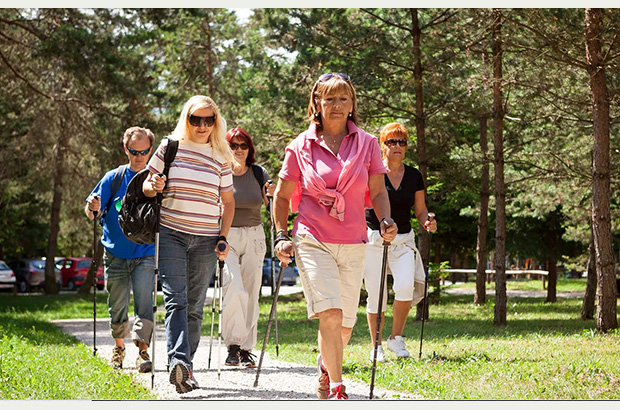
Nordic walking is an excellent gymnastics exercise for any age or the level of physical fitness
The technique of using trekking poles when practicing Nordic walking is no different from mountain walk or classic skiing techniques. The upper body is actively involved in the movement, providing the necessary gymnastic load on the shoulders and back. Nordic walking is an excellent gymnastics for older people, as well as a rehabilitation exercise in case of injuries or diseases of the spine.

Nordic walking is higher in the intensity than normal walking, but lower intensity than running. With a better distribution of the load on the body because of use of the trekking poles
One final advice: Trekking poles are consumable equipment. They break easily, especially if you have not yet learned how to use them well. Therefore, with a large selection of different available models, you should not be guided by the principle “the more expensive is the better.”
In the case of carbon trekking poles, this principle will definitely not lead you to the right choice - that was tested in practice. Read my review of the Camp Sky Carbon Evo Trekking Poles. Spoiler: rare shit for 170 USD.
The author of the text and photos - Alex Trubachev
Your professional technical mountain guide
MCS EDIT 2024
Other related questions:
- Belay device categories
- How to choose your first rockclimbing shoes?
- Independent team of two
- Safety illusions in the mountains
- Gear for basic alpine programs
- Do I need to buy a lot of expencive gear?
- Basic first-aid kit
- Basic expedition rations
- Overview of the X-Light iceaxe of the manufacturer C.A.M.P.
Our Principles
AlexClimb Rule #1 - Safety First
From the very beginning of our activity, here nearly 16 years, the first Principle of work of School of mountaineering and rock-climbing of MCS AlexClimb is the Safety Priority. On the basis of this Principle all process of training is based, all programs and rounds are developed and carried out only within this main principle. We consider that at professional approach to development of programs, at personal discipline and correctly put motivation - occupations by mountaineering and rock-climbing are COMPLETELY safe. And from the return - all troubles and accidents in our sport come from nonprofessionalism, from ignorance or neglect by elementary standards of safety, from irrational motivation, from revaluation of own forces and opportunities. All these prerequisites we COMPLETELY EXCLUDE in our work - ours Rock-climbing, Ice climbing and Mountaineering are based on one Principle - the Safety Priority. In rock-climbing, mountaineering and ice climbing, the Priority of Safety of MCS AlexClimb-is your personal security and comfort irrespective of, than we are engaged - we train muscles and we work technology of the movement in the sports hall and on the rock climbing wall, we make the way through snowstorm to top or we relax on golden sand of the Caribbean beach after hot day of trainings on rocks. The Safety priority - the main credo of School of mountaineering and rock-climbing of MCS AlexClimb.
AlexClimb Rule #2 - Leave No Trace
Closely interacting with Nature, working with the active programs in mountains, woods, lakes and rivers, we perfectly understand the importance of carefull and respectfull bahavior towards the Nature, for its resources. From the very beginning of our outdoor-activity we adopted rules of Leave No Trace technique - the standard of behavior of the person accepted in all the civilized world in relation to environment and especially - to the wild nature. After all on the relation of people to the nature near which they exist, itself can draw dalekoidushchy conclusions on the relation of these people to... Where and as we didn't travel - we don't reserve any garbage, we try to reduce whenever possible our influence on environment to a minimum. We clear earlier zagryazyonny tourist parking of the left garbage, we take out and we take out to utilization places that to us other people left there. We consider that only thus, at personal individual consciousness of each citizen, each tourist, climber or autotraveller, we will be able to keep the nature surrounding us in its state, natural, suitable for life, - in it pledge of the healthy future for ourselves and our children.





